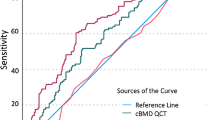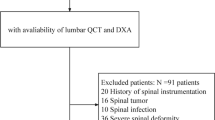Abstract
Quantitative computed tomography (QCT) was compared to dual X-ray absorptiometry (DXA) measured in the lumbar spine of 508 European women defined as normal without fracture (NoF), or osteoporotic (OP), with either vertebral fracture (VF), or peripheral fracture (PF). The correlations between QCT and DXA BMD measurements were significantly different in normal and in osteoporotic patients, indicating that the two exams do not measure the same bone aspects. According to ROC curves results, QCT Z-scores separate OP from NoF with better sensitivity than all other measurements. A threshold to differentiate OP from NoF was chosen at Z-score=−1 for DXA-BMD and −1.5 for QCT-BMD. VF patients showed a highly significant decrease in BMD by DXA or QCT. PF patients revealed measurements lower than those of normal subjects but greater than those of VF, calling into question the idea of a diffuse osteoporosis causing nonvertebral fractures that is measurable by spinal DXA or QCT. DXA is weakly dependent upon age, and T-score or Z-score are equivalent for evaluating osteoporosis. QCT depends greatly upon age, and Z-score appears to be more efficient.
Similar content being viewed by others
References
Cann CE, Genant HK (1980) Precise measurements of vertebral mineral content using computed tomography. J Comput Assist Tomogr 4:493–500
Reinbold WD, Genant HK, Reiser UJ, Harris ST (1986) Bone mineral content in early-postmenopausal and postmenopausal osteoporotic women: comparison of measurement methods. Radiology 160:469–478
Ott SM, Kilcoyne RF, Chesnut CH III (1987) Ability of four different techniques of measuring bone mass to diagnose vertebral fractures in postmenopausal women. J Bone Miner Res 2:201–210
Heuck AF, Block J, Gluer CC, Steiger P, Genant HK (1989) Mild versus definite osteoporosis: comparison of bone densitometry techniques using different statistical models. J Bone Miner Res 4:891–900
Pacifici R, Rupich R, Griffin M, Chines A, Susman N, Avioli LV (1990) Dual energy radiography versus quantitative computer tomography for the diagnosis of osteoporosis. J Clin Endocrinol Metab 70:705–710
Kleerekoper M, Nelson DA, Flynn MJ, Pawluszka AS, Jacobsen G, Peterson EL (1994) Comparison of radiographic absorptiometry with dual energy X-ray absorptiometry and quantitative computed tomography in normal older white and black women. J Bone Miner Res 9:1745–1749
Guglielmi G, Grimston SK, Fisher KC, Pacifici R (1994) Osteoporosis: diagnosis with lateral and postero-anterior dual x-ray absorptiometry compared with quantitative CT. Radiology 192:845–850
Jergas M, Breitenseher M, Gluer CC, Yu W, Genant HK (1995) Estimates of volumetric bone density from projectional measurements improve the discriminatory capability of dual X-ray absorptiometry. J Bone Miner Res 10:1101–1110
Yu W, Gluer CC, Grampp S, Jergas M, Fuerst T, Wu CY, Lu Y, Fan B, Genant HK (1995) Spinal bone mineral assessment in post-menopausal women: a comparison between dual X-ray absorptiometry and quantitative computed tomography. Osteoporos Int 5:433–439
Lafferty FW, Rowland DY (1996) Correlation of dual-energy x-ray absorptiometry, quantitative computed tomography and single photon absorptiometry with spinal and non-spinal fractures. Osteoporos Int 6:407–415
Grampp S, Genant HK, Mathur A, Lang P, Jergas M, Takada M, Gluer CC, Lu Y, Chavez M (1997) Comparisons of non-invasive bone mineral measurements in assessing age-related loss, fracture discrimination and diagnostic classification. J Bone Miner Res 12:697–711
Dequeker J, Pearson J, Reeve J, Henley M, Bright J, Felsenberg D, Kalender W, Laval-Jeantet AM, Ruegsegger P, Adams J, Diaz Curiel M, Fischer M, Galan F, Geusens P, Hyldstrup L, Jaeger P, Kotzki PO, Kroger H, Lips P, Mitchell A, Louis O, Perez Cano R, Pols H, Reid DM, Ribot C, Schneider P, Lunt M (1995) Dual X-Ray absorptiometry — crosscalibration and normative reference ranges for the spine: results of a European Community concerted action. Bone 17:247–254
Kanis JA (1994) Assessment of fracture risk and its application to screening for post-menopausal osteoporosis: synopsis of a WHO report. Osteoporos Int 4:368–381
Mazess RB (1987) Bone density in diagnosis of osteoporosis: thresholds and breakpoints. Calcif Tissue Int 41:117–118
Ross PD, Wasnich RD, Heilbrun LK, Vogel JM (1987) Definition of a spine fracture threshold based upon prospective fracture risk. Bone 8:271–278
Smith-Bindman R, Cummings SR, Steiger P, Genant HK (1991) A comparison of morphometric definitions of vertebral fracture. J Bone Miner Res 6:25–34
Audran M, Renier JC, Clochon P, Chaleil D, Auvinet B, Bileckot R, Simon Y, Jallet P (1989) Etude par absorptiométrie photonique dichromatique de la densité osseuse vertébrale. Influence de l’âge, du sexe, de la ménopause et du morphotype. Rev Rhum Mal Ostéoartic 56:141–146
Cann CE, Genant HK, Kolb FO, Ettinger B (1985) Quantitative computed tomography for prediction of vertebral fracture risk. Bone 6:1–7
Hanley JA, McNeil BJ (1983) A method of comparing the areas under receiver operating characteristic curves derived from the same cases. Radiology 148:839–843
Eastell R, Wahner HW, O’Fallon WM, Amadio PC, Melton LJ III, Riggs BL (1989) Unequal decrease in bone density of lumbar spine and ultradistal radius in Colles’ and vertebral fracture syndrome. J Clin Invest 83:168–174
Avouac B, Julien D, Laval-Jeantet AM, Sulman T, Ulmann A, Caulin F (1990) Reproducibility of the reading of radiological spine diformity. In: Christiansen C, Overgaard K (eds) Osteoporosis 1990 Osteopress, Kobenhavn, Denmark, pp 537–569
Kleerekoper M, Villanueva AR, Stanciu J, Sudhaker R, Parfitt AM (1985) The role of three-dimensional trabecular microstructure in the pathogenesis of vertebral compression fractures. Calcif Tissue Int 37:594–597
Biggerann M, Hilweg D, Seidel S, Horst M, Brinckmann P (1991) Risk of vertebral insufficiency fractures in relation to compressive strength predicted by quantitative computed tomography. Eur J Radiol 13:6–10
Jones CD, Laval-Jeantet AM, Laval-Jeantet MH, Genant HK (1987) Importance of measurement of spongious vertebral bone mineral density in the assessment of osteoporosis. Bone 8:201–206
Riggs BL, Melton LJ III (1983) Evidence for two distinct syndromes of involutional osteoporosis. Am J Med 75:899–901
Earnshaw SA, Cawte SA, Worley A, Hosking DJ (1998) Colles’ fracture of the wrist as an indicator of underlying osteoporosis in postmenopausal women: a prospective study of bone mineral density and bone turnover rate. Osteoporos Int 8:53–60
Kalender WA (1992) Effective dose values in bone mineral measurements by photon absorptiometry and computed tomography. Osteoporos Int 2:82–87
Njeh CF, Fuerst T, Hans D, Blake GM, Genant HK (1999) Radiation exposure in bone mineral density assessment. Appl Radiat Isotopes 50:215–236
Genant HK, Engelke K, Fuerst T, Gluer CC, Grampp S, Harris ST, Jergas M, Lang T, Lu Y, Majumdar S, Mathur A, Takada M (1996) Non-invasive assessment of bone mineral and structure: state of the art. J Bone Miner Res 11:707–730
Ito M, Hayashi K, Ishida Y, Uetani M, Yamada M, Ohki M, Nakamura T (1997) Discrimination of spinal fracture with various bone mineral measurements. Calcif Tissue Int 60:11–15
Devogelaer JP, Maldague B, Malghem J, Nagant de Deuxchaisnes C (1992) Appendicular and vertebral bone mass in ankylosing spondylitis. A comparison of plain radiographs with single and dual-photon absorptiometry and with quantitative computed tomography. Arthritis Rheum 35:1062–1067
Laval-Jeantet AM, Bergot C, Williams M, Davidson K, Laval-Jeantet M (1995) Dual-energy X-ray absorptiometry of the calcaneus. Comparison with vertebral dual-energy X-ray absorptiometry and quantitative computed tomography. Calcif Tissue Int 56:14–18
Author information
Authors and Affiliations
Rights and permissions
About this article
Cite this article
Bergot, C., Laval-Jeantet, A.M., Hutchinson, K. et al. A comparison of spinal quantitative computed tomography with dual energy X-ray absorptiometry in European women with vertebral and nonvertebral fractures. Calcif Tissue Int 68, 74–82 (2001). https://doi.org/10.1007/BF02678144
Received:
Accepted:
Published:
Issue Date:
DOI: https://doi.org/10.1007/BF02678144




